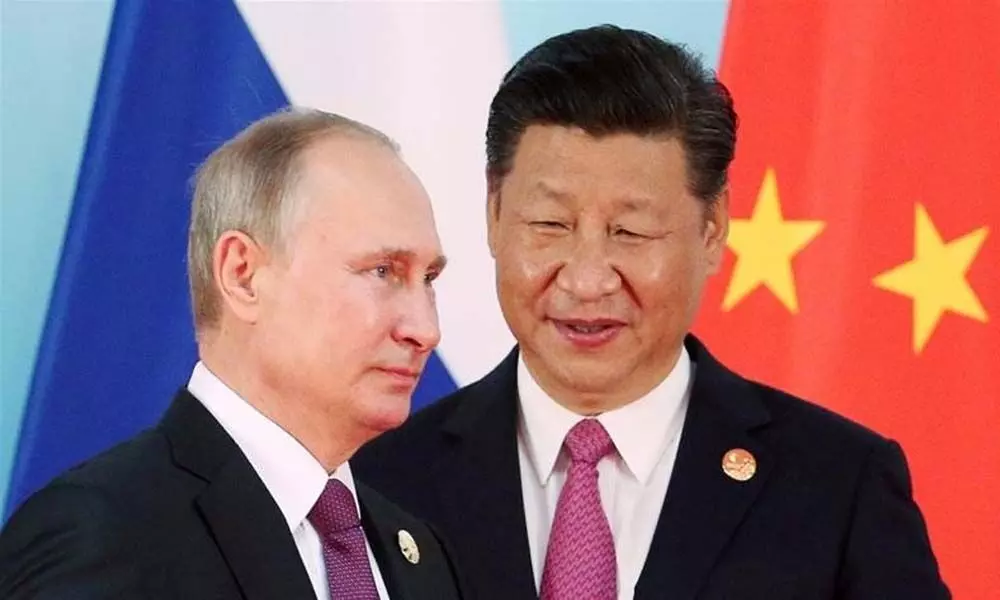Putin's worry: How to break dollar dominance?
Russia's share of exports sold in the US currency fell below 50 per cent for the first time in the fourth quarter of 2020
image for illustrative purpose

THE most effective weapons in America's tussle with strategic and economic competitors may be 100 US cents.
Countries like Russia and China chafe at the dollar's dominance, but there's little they can do other than posture and make relatively benign adjustments to their monetary arrangements. Russian President Vladimir Putin acknowledged as much late last week, telling journalists that "we don't want to do away with it, because it's a universal currency." China's campaign to internationalize the yuan, which received backing from the International Monetary Fund in 2016, is going nowhere fast.
Putin spoke after Russia's oil fund said it will eliminate holdings of dollars and shift them into euros, gold and the yuan. The transfers will take place within the central bank's reserves and there was little impact on markets. The backdrop to all this is Russia's objection to sanctions that Washington has applied since Putin annexed the Crimean Peninsula from Ukraine in 2014. The country has since tried to reduce its exposure to the American asset. In 2019, State oil giant Rosneft moved its export contracts into euros. Russia's share of exports sold in the US currency fell below 50 per cent for the first time in the fourth quarter of 2020.
Despite its harumphing, Russia has acknowledged the buck is so ubiquitous in global commerce that it's hard to function as a modern society without it. The dollar accounts for almost 60 per cent of global central bank reserves and 88 per cent of foreign-exchange transactions are against the U.S. currency. About half of cross-border loans and international debt securities are denominated in greenbacks. When markets seized up early in the Covid-19 pandemic, it was the Federal Reserve — not the Bank of Russia or the People's Bank of China — that threw its arms around the world financial system.
But is the dollar's primacy impregnable? There are reasons to be skeptical. Record U.S. budget deficits will involve the sale of more Treasury bonds that boost the global supply of the currency, and the trade deficit is growing. (Neither is a new argument.) While central bank reserves dominated in dollars account for 59 per cent of the total, that is the lowest level in 25 years, according to the IMF. The Fed's actions in March 2020 were effective in preventing a public health crisis from becoming a financial cataclysm, but the institution is acutely sensitive to the climate in Congress. Lawmakers can clip its wings anytime they wish. The Fed has avoided this clash so far; the overseas central banks that received dollar-swap lines when the pandemic erupted are US allies or partners. It would be tough for the Fed to give a swap line to, say, China or even Hong Kong. Policy makers would be hammered on Capitol Hill. Ultimately, those red lines may hamper effectiveness.
Beijing's bid to boost the profile of the yuan has yielded meager returns to date, but is seen as a long-term play. The country's gross domestic product is expected to exceed America's by the end of this decade. China will contribute more than one-fifth of the total increase in the world's GDP through 2026, according to Bloomberg calculations based on IMF forecasts. The U.S. and India will be the second and third-biggest, with Japan and Germany rounding out the top five.
However, raw size may miss some underlying dynamics of regions where the greenback holds sway, even if outside US borders. The share of the dollar zone, defined as economies whose currencies vary less against the buck than the euro or other key currencies, has remained at 50 per cent to 60 per cent of world GDP, wrote Robert McCauley, a nonresident senior fellow at Boston University's Global Development Policy Center. "While the dollar zone has shrunk geographically as the line between the euro and dollar has moved east in Europe, faster growth in more dollar-linked Asia has maintained the dollar share," McCauley, a former official at the Fed and Bank for International Settlements, said in a paper this year.
Given this firepower, might the US overreach and encourage more places to diversify? For all the popular fascination with Chinese aircraft carriers and anxiety about Putin throwing his weight around, Washington has readily deployed dollar diplomacy — or dollar weaponry. Russia finds this a source of great irritation. "Geopolitics does play a role," Finance Minister Anton Siluanov told state television at the St. Petersburg International Economic Forum last week. "We're trying to protect our investments."
Russia, China and other adversaries will keep trying to chip away at dollar supremacy. They may even have some success at the margins. To replace the buck, a pretender to the throne needs to have U.S. attributes, including deep and liquid capital markets, an independent central bank and rule of law, to name a few — and none of its flaws. People are right to fret about an increasingly polarized political system, which can retard policy making and the erode perceived legitimacy of core institutions. The insurrection in January, when crowds of pro-Donald Trump supporters stormed Congress, was a lesson in the explosive margins of democracy and caused great reputational damage. And at some point, Americans may lose the appetite for the global economic, diplomatic and military responsibilities it has shouldered since 1945.
Until then, prepare for a dollar future. You don't have to take Fed Chair Jerome Powell or President Joe Biden's word for it, though. Putin has done the work for them. (Bloomberg)

